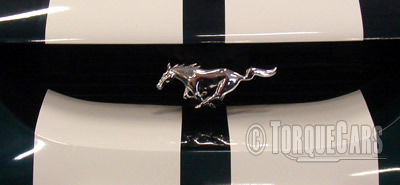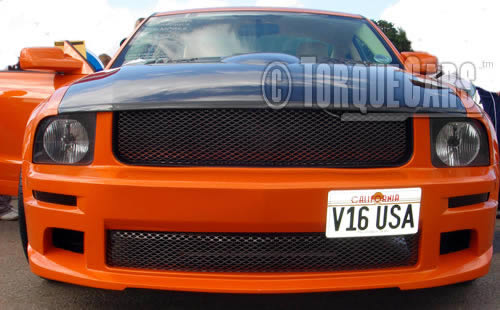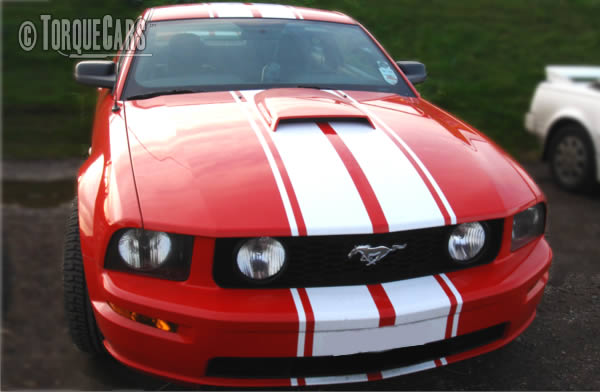Tuning the Ford Mustang
"The birth of an Iconic American Muscle Car"
Let's see what can be done to improve the performance and handling of the awesome Ford Mustang range, from simple engine mods to larger conversions.
First, though, lets look at the history of this iconic American muscle car. The Ford Mustang first appeared in 1964.
It is one of the longest running production models in the world and has a thriving community of tuners and car modifiers.
It was not until 1994 that an extensive and somewhat controversial restyling took place, engine choices ranged from a 3.8 litre to the 5.4 litre.
In 2005 the mustang was restyled and relaunched recapturing the essence of the original car with its quad headlamp arrangement.
There are a lot of performance tuners and modifiers around specialising in the Mustang. For example the Shelby GT model is based upon the standard Ford GT.

It has been extensively tuned and with the Shelby upgrades produces 319 brake horsepower. Then in 2007 a 500 brake horsepower model was produced using a supercharged 5.4 litre V8 engine. These power gains show the potential for tuning in the basic mustang models, and these tuned Mustangs can make even more power.
Roush Performance and Saleen Autosport have also produced some high power versions of the Ford Mustang. There is certainly no shortage of performance Mustang parts available. With a fairly substantial outlay and some careful planning it is possible to run a sub 10 second quarter mile time.
Most owners spend some time tweaking and enhancing the suspension aiming to improve the handling of the car. Handling mods are quite important and we suggest fitting stiffer shocks all round. A drop of around 40-50mm will lower the centre of gravity and we have noted big cornering gains through tweaking the camber and toe settings, particularly at the front with toe out and some negative camber. The exact settings depend on your engine and model year but this is the sort of thing you can discuss in our forum with our other Mustang owners.

Engine Tuning modifications.
Peak power is all well and good but if you want a truly driveable car it will need a wide power band and lots of low down torque. Whilst a lot of car part makers will claim peak BHP figures what you really need is a dyno plot showing the full torque curve.
One of the most significant engine mods you can do is to fit a fast road cam. You will need to ensure that the engine is not starved of fuel so will need to uprate the fuelling. Older carb fed engines have been successfully converted to fuel injection although purists will make the case for keeping the Carburetor and going to larger sizes.
It is the injectors and the fuel pump that will need to be uprated if you want to prevent your engine from running lean and this does need to be worked out in line with the mods you decide to do on your Mustang.
Internal head work ensures that the engine breathes as efficiently as possible. A 3 or 5 angle valve job will also make a big difference to mid range torque and low end power. The headers and exhaust manifolds should also be upgraded if you are serious about big performance gains on your Mustang.
The larger power gains come from forced induction with a choice of either, a supercharger or turbo kit. Many of these bolt on and a 5 psi boost can raise horsepower by 115-120! We have even seen Mustangs hitting power figures around 1000bhp and pulling sub 10 second quarter mile runs.
With some additional internal engine work higher boost can be applied leading to significant performance gains. Attention will also need to be spent upgrading the exhaust for a better flowing exhaust system and also the air intake can be improved. Some owners complain that third gear is annoying so upgrading the gear box for a closer ratio box and short throw shifter will also makes the car more pleasant to drive.
Intake and exhaust modifications.

Let's move on to the engine intake and exhaust and ensure proper flow through the engine.
The maximum power gains generally come from a full induction kit with a cold air feed, this can be sited within an air box but a panel filter should suffice for most applications.
Our forums are a good place to ask about which mods are most suitable for you car. Fitting a high flow sports exhausts will certainly help air flow through the engine but do not go too large or you will reduce the flow rate.
Stick to 2 to 3 inches for best results. See our article on performance exhausts for details of the issue around large bore exhausts and how to choose the right size for your engine.
Engine wise TorqueCars would recommend that you get the head properly flowed, then fit some fast road cams. Following these mods you are best advised to get a proper dyno tune and ensure that the car is set up properly, paying close attention to the fuel and air ratio.
Gas flowing the head will allow you to maximise your air/fuel charge. Leave this to a professional though with a proper flow bench and machine tools Your clutch can sap a lot of your power if it starts to slip and the standard clutches are only ever good for power gains of up to 40 or 50%. Fit a performance clutch to avoid power losses through the transmission.
Supercharged and Turbocharged engines are just begging to be remapped. You will see big power gains on most turbo engined cars including diesels making a remap one of the most cost effective modifications.Despite the large cost involved adding forced induction to a NASP engine will give large power gains. Turbos are harder to add than supercharger. With a turbo the boost curve is related exponentially to the engine speed making it hard to map. The nice steady boost to rpm characteristics of the supercharger make them easier to map. To cope with forced induction you will usually need to decrease the compression ratio of the engine.
You will also need to increase the size of the throttle body as appropriate to maximise air flow into the engine.
Wheel modifications.
Alloy wheels will help the brakes cool down and are usually lighter than the steel ones. It is worth noting that although they can look cool on the Mustang Big alloy wheels will actually decrease your performance. The larger you go the lower your acceleration will be - this is due to the change in your effective final drive ratio. Although some people have gone larger we would stick to a 19 inch rim size as the maximum although some owners go larger than this with little reported side effects.
Please join our forums to discuss tuning modifications with other members who have Mustangs and browse our tuning topics for indepth information on the various aspects of engine and car modification.
Please Check out my YouTube channel, we're regularly adding new content...
PLEASE HELP: I NEED YOUR DONATIONS TO COVER THE COSTS OF RUNNING THIS SITE AND KEEP IT RUNNING. I do not charge you to access this website and it saves most TorqueCars readers $100's each year - but we are NON PROFIT and not even covering our costs. To keep us running PLEASE Donate here
If you liked this page please share it with your friends, drop a link to it in your favourite forum or use the bookmarking options to save it to your social media profile.
Feedback - What do You Think?
Please use our forums if you wish to ask a tuning question, and please note we do not sell parts or services, we are just an online magazine.
Help us improve, leave a suggestion or tip
Please watch this video and subscribe to my YouTube channel.


 Click to accept YouTube Cookies & Play.
Click to accept YouTube Cookies & Play.